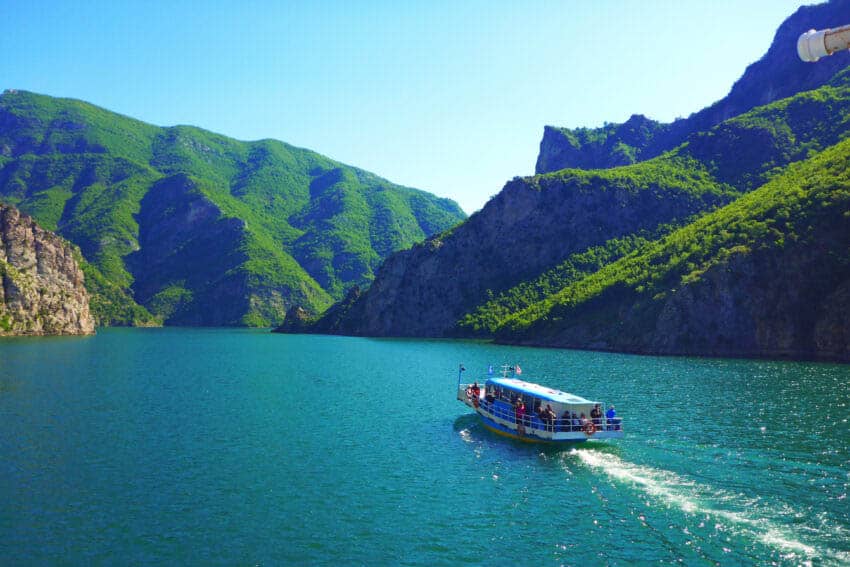By Terry Braverman
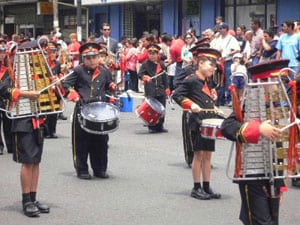
It’s 6 p.m. on the eve of Independence Day and Costa Rica has screeched to a halt, as the national anthem is warbled by a countrywide choir of all Costa Ricans.
The flickering of lanterns around me reflects the re-creation of history, specifically, the decree issued from Congress in Guatemala City on September 15, 1821.
Costa Rica was officially declared independent from the Central American colonial government. However, nobody told the Costa Ricans about it for nearly a month, due to the absence of phones, faxes, or e-mails.
Messengers Spread the Word
According to legend, messengers heroically spread the word at night, toting small lanterns to illuminate their path, and raced across the entire country on foot without the use of performance-enhancing drugs.
Costa Rica’s tumultuous history is more geological than political. The country is blanketed by 112 volcanic formations, created eons ago as part of the Pacific Rim of Fire which accounts for 81% of all major earthquakes.
Seven volcanoes are active, and their combinations of orgasmic ooze and incendiary explosions were a deterrent for the earliest human inhabitants of 10,000 years ago to expand their territories.
The first sizeable settlement was recently unearthed near Turrialba, where an estimated 10,000 people lived around 1000 BC. Known today as Guayabo National Monument, it is the largest, most important archaeological site in the country. Excavators discovered paved sidewalks, a cobblestone road entering the village, aqueducts, tombs, and circular mounds serving as foundations for buildings that were five stories high.

Petroglyphs of symbolic animal images, like the jaguar (god of the forest) and crocodile (god of the river), have been found.
But if you’re expecting the magnitude of Tulum or Tikal here, you will be disappointed. Nevertheless, much of the area remains to be excavated, and it is still fascinating enough now.
There is no evidence yet as to why this well-developed community was abandoned by 1400 AD; perhaps their sixth sense forewarned them of the conquistadores just around the historical bend.
Columbus in Costa Rica
On September 18, 1502, Christopher Columbus made Costa Rica the final stop on his farewell tour. As he set anchor for the last time in the New World, a group of native Caribs paddled out in their canoes to greet him heartily, perhaps gifting him a gold watch for retirement. Well….unlikely, but possible — watches were invented around 1500.
A few years later, gold trinkets that the locals wore in their ears and noses would inspire writer Gil Gonzalez Davila to name the country Costa Rica, or “Rich Coast”. This was an oxymoron to the original colonists, who believed there were fewer valuable or easily exploitable resources than other New World destinations. Costa Rica was an outcast among Spanish colonies.
It was a tough gig for the early settlers, who were left much to their own devices by the mother country. Eventually, the first colonial city was established in 1562 when Juan Vasquez de Coronado founded Cartago, the fledgling nation’s first capital. Soon after, the first church was constructed in Ujarrás.
In the late 1700s, the cultivation and commercialization of coffee finally changed the backwater status of a colony that had languished in a corner of the Spanish Empire. Coffee induced an enormous adrenalin jolt of prosperity for Costa Rica, modernizing the country while birthing an elite class of plantation owners.

Shortly after independence in 1821, a civil war broke out between Cartago, which wanted to be part of a federation with the rest of Central America, and the more sovereign-minded city of San José.
Cartago was defeated, making San José the new capital. The coffee barons later overthrew the country’s first president, José Maria Castro, who was succeeded by Juan Rafael Mora in 1849. It was under Mora’s leadership that Costa Rica repelled a repulsive American named William Walker.
A Repulsive Man
How repulsive was he? A Santa Rosa National Park ranger (and well-informed historian) by the name of Juan was hesitant to say, knowing that I’m an American.
But I egged him on with my ace investigator persona, and Juan’s dark brown eyes lit up like hot coals. History clearly gets his engine revved up. Reserved at first, he was now firing on all cylinders, avowing that “Walker was a disgruntled, boozing southerner with an extreme case of aggressive/compulsive behavior.” (Just give someone an opening to rag on a Yankee imperialist, and…..)
He continued: “Walker thought the United States should annex Central America and convert it into a slave state. Offering to ‘help’ one of the warring parties in neighboring Nicaragua’s civil war, he connived his way into being President of that country.
Afterward, he turned his sights on Costa Rica, setting up shop with 250 soldiers right here, just inside the Costa Rican border. What ensued was perhaps the shortest battle in human history — an amateur army of 450 volunteers, led by the heroic charge of Juan Santamaría, routed Walker’s forces in 15 minutes.
Walker tried again to invade Costa Rica, then Honduras, and was ultimately shot by a Honduran firing squad.”
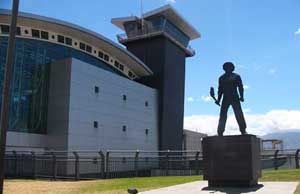
Controversy exists over the birth of Señor Santamaría. My ranger informant said, “There was no birth certificate of record with his name during that time frame.
Based on a valid document from his hometown, historians claim he was born in 1831, as an illegitimate mulatto son.” How ironic it is, in a country so family-oriented, its most famous hero was born out of wedlock, and they named the international airport after him.
In 1859, a coup engineered by a bloc of coffee honchos brought to power José María Montealegre, whose credentials were highly questionable. Having studied in England for many years, he reputedly spoke better English than Spanish.
However, there is no evidence of a doctoral degree he claimed to receive in Edinburgh or any document in Edinburgh about his graduation. “He was just a shyster who never finished school,” quipped Juan.
Military rule reared its head over time, though not marked by long-term violent extremism that has occurred elsewhere in Central America. Costa Rica became a full-fledged democracy after a brief civil war erupted in 1948, when incumbent Rafael Angel Calderon refused to relinquish power despite losing the presidential election.
An exile named José Maria Figueres Ferrer defeated Calderon in a month and later proved to be one of Costa Rica’s most influential leaders.
Reforming Civil Rights
Ferrer made vast reforms in policy and civil rights — he granted women and blacks the right to vote, nationalized banks, established presidential term limits, abolished the army for good, and created the Costa Rican Institute of Tourism (ICT), which sponsored part of my trip. My favorite President!
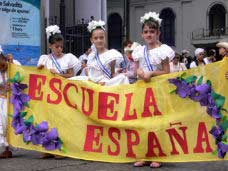
A new constitution was adopted in 1949, and the ruling junta transferred power to Otilio Ulate as the newly-elected president. Apparently, there wasn’t much left for him to do.
The most noteworthy event during his four-year tenure, according to the book Anecdotario Nacional, one morning while walking to the Presidential Palace, he was run over by a bicycle.
Ferrer was elected for a third and final term as President from 1970-74. Working his magic, he was able to secure international funding for some major social programs, but the funds reportedly disappeared.
When asked by a journalist what he had to show for it, he replied, “Well….it was a lot of money. But I can show you the leftover spare change.”
In 1979, Sandinista rebels from Nicaragua were allowed to set up a training camp at Santa Rosa in preparation for overthrowing the widely despised Somoza regime. Many Costa Ricans assisted in their cause.
“One of my cousins ran arms, food, and supplies across the border to the Sandinistas,” said Juan. “However, the tables turned after the Sandinistas seized power. We became nervous about the spread of communism, and the Contras (anti-Sandinista rebels) usurped the training camp once run by the Sandinistas, with our government’s blessing.” He also mentioned that a secret airstrip was built there, by the notorious Oliver North.
Eight years later, Costa Rican President Oscar Arias Sanchez garnered world recognition when he won the Nobel Peace Prize for his work in ending the Nicaraguan civil war. He was able to persuade all five Central American presidents to sign his peace plan, and Nicaragua is now experiencing the relative stability that Costa Rica has enjoyed since 1948.
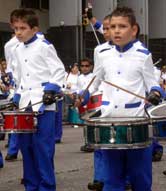
Fast forward to the present. I’m watching a parade of kids who look like they exited straight from the cleaners into marching formation with their impeccably clean, pressed uniforms. Schools from across the land strut down the street in waves, a sea of color and pageantry.
There are groups of drummers, followed by ensembles of xylophone players, succeeded by gyrating hula hoopers, trailed by twirling streamers. Proud parents are beckoning from curbside, some waving their arms and others timing their perfect Kodak moment.
Families and special occasions remain the primary source of entertainment for most Ticos (Costa Ricans). I wondered how many of them know just how entertaining their history really is.
WHERE TO STAY, EAT, AND GO (OR NOT)
CARTAGO AREA
San Chiri Mirador & Lodge – perched high in the mountains with a riveting view of Valle de Orosi and Rio Reventazon, San Chiri’s cool climate is the perfect place to chill. This family-run lodge will accommodate you in rustic but cozy cabins, with a typical Tico breakfast of Gallo pinto (rice and beans), papaya, pineapple, huevos revueltos (scrambled eggs), crisp-crusted bread with guava jelly, and robust Costa Rican coffee.
An added bonus is the enclosed butterfly garden on the property, a great way to start your day.
Location: About six kilometers SE of Cartago, close to the town of Paraiso
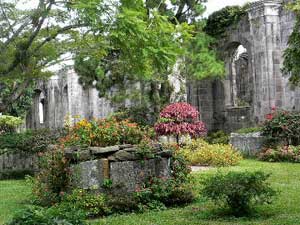
Las Ruinas – the oldest church in Cartago, it was destroyed by an earthquake in 1910 and never rebuilt. A pleasant spot to park yourself and people watch. Beyond the standing walls is a lovely garden.
Location: Downtown Cartago (Avenida 2, Calle 2)
Basílica de Nuestra Señora de Los Angeles (Basilica of Our Lady of the Angels) – the flagship church of Costa Rica, dedicated to La Negrita, the patron saint of Costa Rica.
On August 2, tens of thousands of people support the podiatry profession annually by walking to Cartago from all parts of the country in honor of La Negrita, the patron saint of Costa Rica. Miraculous healing powers have been attributed to La Negrita, and over the years, many pilgrims have come to the shrine seeking cures for their illnesses and difficulties.
Location: Cartago, east of Downtown (Avenida 2, Calle 16)
La Puerta del Sol – reputedly the oldest restaurant in Cartago. I ordered a Casado (combination plate) for lunch that included Arroz con palmito. Palmito is the starchy, slightly sour heart of the palm plant. Nothing to write home about, but filling and decent nevertheless at $4.50.
Location: Cartago, across from the Basilica.
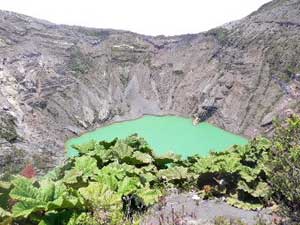
Irazu Volcano National Park – highest active volcano in Costa Rica (3432 meters), though nowadays it just sits there and fumes harmlessly.
Traipsing on its lunar-like surface, and gazing into an eerily bright green lake from the lip of the crater, is like being an extra in a sci-fi movie. Advisable to bring a sweater or jacket, as it gets chilly there.
Open from 9-4 pm. Admission: $7.
Location: About 30 kilometers NE of Cartago on Highway 8
Las Ruinas de Ujarrás – the ruins of the country’s oldest church (built around 1564), whose tranquil gardens are a great vantage point to sit and gaze at the silhouetted mountains.
Every year, on the closest Sunday to April 16, a procession from Paraiso celebrates the day of La Virgin de Ujarrás with a mass, followed by music and food.
Location: Ujarrás, about seven kilometers east of Paraiso
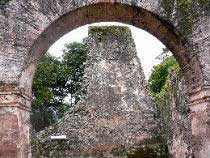
La Casa del Soñador (The House of the Dreamer; tel. 577-1186) is the home and gallery of the late wood sculptor Macedonio Quesada and sons. The elder Quesada was an art professor at the University of Costa Rica who reputedly slept with many of his fawning students, enough to have him exiled to this remote community.
His sons Hermes and Miguel carry on the family tradition (wood sculpting, that is). A good place to browse for well-crafted gift items.
Location: Cachí, about two kilometers past the dam
Orosi Church – another colonial church, built in 1743. A small but interesting museum next door displays religious artifacts, including paintings, apparel, and silver objets d’art.
Location: Orosi, about ten kilometers south of Paraiso
Tapantí National Park – lush hiking trails, waterfalls, as well as riverside picnic areas. Open daily 8-4pm. Admission: $6.
Location: About 15 kilometers SE of Orosi
La Posada de la Luna – a popular country café with locals and tourists alike, serving tasty local food (Tel: 534-4288). Especially hopping at breakfast time with the river rafting crowd, the place features encased historical artifacts, from tools to archeological finds, and photos ranging from local people to celebs like Pele and President Clinton.
Location: Cervantes, between Paraiso and Turrialba
Guayabo National Monument – largest, most important archaeological site in the country. Open daily 8-4pm. Admission: $4.
Location: 19km (12 miles) northeast of Turrialba
TORTUGUERO NATIONAL PARK
Grupo Mawamba – offers a package tour to Tortuguero, including hotel pick-up by bus in San Jose early a.m., stop for breakfast at Rio Danta Restaurant, disembarking at Matina for boat transportation to Mawamba Lodge in Tortuguero; lodging for a selected number of nights, all meals, boat tours on the canals, and hikes in the park lead by a professional bi-lingual guide.
The lodge sits on a forested sandbar with an ocean beach on one side, a canal on the other. The grounds include a pool surrounded by gardens, hammocks, and rooms that blend in compatibly with the rainforest environment. A 15-minute walk takes you into a funky Caribbean village. If it’s turtle nesting season (July thru September), a tour is offered separate from the package, where you can witness turtles laying eggs on the beach after dark.
LA FORTUNA AREA
Arenal Volcano National Park – currently Costa Rica’s most active volcano, flashing dramatic flames, spewing lava, and hurling rocks the size of Hummers. In the past 30 years, this volcano has blown time and again. I appreciated Arenal the most in the evening at a distance when it can paint the sky with quite a pyrotechnical show.
Best viewing spot is the Observatory Lodge, where it’s a two-kilometer stone’s throw from the volcano. Hiking trails of 2 ½ – 3 hours take you to recent and old lava flows. Accommodations and a restaurant are available to the public. Open from 7 am-10 pm daily. Admission: $3.
Location: west of Fortuna, drive 15 kilometers, left at the sign, then 9 km to the lodge
La Choza de Laurel – A delicious seven-course meal was served for lunch here at a reasonable price ($5.20). Tel: 479-9231.
Location: Fortuna, immediately on your right, after turning left off the road from San Ramon
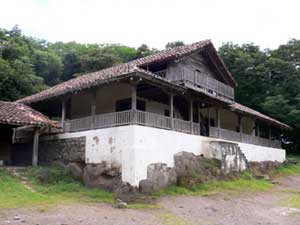
SANTA ROSA NATIONAL PARK
The restored hacienda house of William Walker’s brigade commemorates the historic battle here. In addition, the park protects the largest remaining tropical dry forest in Central America and has important turtle nesting grounds as well.
Therefore it is a melting pot for biologists and other researchers of the natural world. Open 9-4 pm daily. Admission: $3.
Location: About 35 km north of Liberia
PLAYA DEL COCO
Villa del Sol Bed & Breakfast Inn – a real charmer, situated 150 meters from the beach. Besides the three upstairs rooms in the main house, there are six studio apartments in a separate building with ocean views. The main house has a balcony with an ocean view, plus a large central atrium that imparts a warm, bright, airy feel to the place. On the property sits a swimming pool, a large covered BBQ area, and a snack bar, surrounded by tropical gardens.
Location: Playa del Coco, about 30 km south of Liberia
Restaurant Papagayo – The fresh catch of the day was a scrumptious red snapper, cooked New Orleans style. They have an all-you-can-eat special, and good service as well. Open 11:30am-10pm. daily.
Location: Playa del Coco, the center of town
Rich Coast Diving – offers tours, sunset cruises, and everything you need for diving and snorkeling equipment, including PADI training for groups and individuals
Location: Playa del Coco, the center of town
BAGACES
Llanos de Cortes waterfall – a hidden gem not found in any guidebooks I’ve seen. Magnificent falls surrounded by a sandy, gold-speckled beach and lush rainforest.
Location: Heading south from Liberia on the Interamerican Highway, the junction is about four kilometers before you get to Bagaces, but there is no sign. There is reportedly a sign going the opposite way through Bagaces (“Catarata”). The turnoff is on the west side of the highway, with the dirt road between a small soda and a house. Follow the road for about 1km and there will be a sign which says “Catarata 1km” (it’s actually a bit farther).
LAS JUNTAS
Ecomuseo Minero (Ecomuseum of Mining) – it seems they call it an “Ecomuseo” as a marketing ploy, to ride the ecotourism popularity. But it is an interesting, road less traveled adventure thru the somnambulant town of Las Juntas to a museum that depicts the gold mining practices of yesteryear.
Trails behind the museum lead to other mine artifacts, and some excellent wildlife watching. I saw an Agouti, a white-faced monkey, and a number of birds in this very remote area. The curator is a robust 72 year old named Romain Vega Cortes, who clearly relishes the company of visitors. Open 9-5pm daily, Admission: $2.
Location: Five km north of Las Juntas. Follow the signs.
MONTEVERDE
Stella’s Bakery & Coffee Shop – They make a savory herb bread that doubled the pleasure of my sandwich. Try one of the desserts for me and report back. Open for breakfast and lunch daily, 6 am-6 pm. Private dinners only. Tel: 645-5560
Location: Monteverde
SAN JOSE
Hotel Balmoral – The best quality about this four-star establishment is the location, right on the pedestrian mall which is the cultural/commercial heart of San Jose. Yes, there’s a sauna and massage service in the hotel, and the staff is amiable enough.
But this place is mucho blando. The view out the window was a maze of plastic panels joined by angular steel pipes that is part of the atrium in the hotel. I couldn’t ask for a more impersonal view unless I was staring at the room itself.
In the bathroom, the shower head was like a pressurized fire hose, and the bath towels looked pre-shrunk. The included breakfast was a heavy carb affair (rice and beans, potatoes, bread) with a dearth of energy-inducing protein. Unless you thrive on being where the action is for location, I don’t recommend the Blahmoral.
Location: Avenida Central, between Calles 7-9
Raya Vida Bed & Breakfast – a beautiful antebellum home tucked away at the end of a quiet cul-de-sac, yet a twelve-minute walk to the pedestrian mall. This would seem to be the best of all worlds in the city, except for the fact that the owner and two party animal guests separated me from my sleep until 1:30 a.m. with raucous chatter, loud music, and no apology. Not recommended, unless you actually think a B&B is for partying.
Location: Santa Teresita district, end of Calle 17
Restaurant El Sesteo – authentic, simple, unpretentious Tico eatery with an L-shape design. A good value at $4 for a hefty, tasty lunch.
Location: Avenida 7, between Calles 5-7
Restorante Tinjo – upscale establishment serving Asian cuisine. For $8, I had a yummy yellow curry dish here, just like they make it in L.A….errrr…Thailand.
Location: Calle 11, between Avenidas 6-8
Reservations: 221-7605
Museo Nacional (National Museum) – Housed in what was an army fortress, the museum is surprisingly small and unimpressive. A dab of artifacts and history of indigenous cultures, a smattering of jade and gold, token pieces of colonial furniture and costumes, and a few paintings, including all the Presidents. That’s about it. Not recommended.
Location: Calle 17, between Avenidas Central-2. Open daily 9-4:30 pm. Admission: $1.
Museo de Jade (Jade Museum) – Now we’re talking impressive. Home to the world’s largest collection of Meso-American jade, shared with some fine works of ceramics, stone, and gold, arranged by cultural regions. Bring your camera. The lofty location offers an excellent view of the city. Open Monday-Friday only, 8-4:30 pm. Admission: $2
Location: The 11th floor of Instituto Nacional de Seguros, Avenida 7 between Calles 9-11
Museo de Oro (Gold Museum) – equally as impressive, with a scintillating display of pre-Columbian gold pieces, and a diminutive numismatic museum. Open Tuesday-Saturday only, 10-4:30 pm. Admission: $5.
Location: Under the Tourist Information Office, Plaza de la Cultura, Calle 5 between Avenida Central-2
Museo de los Ninos (Children’s Museum) – a delightfully inventive and comprehensive children’s museum, housed in an old penitentiary. Interactive exhibits teach kids about history, science, geography, ecology, and other matters.
Lots to see here, and worth a visit even if you’re not toting toddlers or teens. Open 9-5pm, Tuesday-Sunday. Admission: $5 adults, lower for kids, depending on age.
Location: Calle 4, north of Avenida 9
Teatro Nacional (National Theater) – the centerpiece of Costa Rican culture. The exterior is pleasant enough in its turn of the 20th century look, but the lobby is more enticing with its sculptures, marble staircases and gilded ceilings. I didn’t take the tour of the building, but it supposedly boasts some fine paintings of Costa Rica. Open 9-4pm Monday-Saturday. Tour: $3.
Location: Plaza de la Cultura, between Calles 3-5
Main Post Office – early 20th century French-influenced eclectic style building, with attractive corner towers and elegant entrance.
Location: Calle 2 between Avenida 1-3
Mercado Central – probably the best place for a cheap meal, procuring T-shirts and other souvenirs, such as live turkeys. Open 8-4pm daily.
Location: Avenida Central between Calles 6-8

Terry Braverman travels internationally as a professional speaker, seminar leader and writer. His primary topic is based on his bestselling book, When the Going Gets Tough, the Tough Lighten Up! For more information, go to this link.
Read more stories by Terry Braverman:
Chiang Mai Thailand: Change in the Air
Hangin’ with the Hill Tribes in Northern Thailand
Vientiane and Vicinity: Savoring Papaya, Pone and French Colonial Charm
Robert Brown sends this comment: “I really enjoyed Terry’s great adventures and telling it as it is. Much interesting, historical, and practical information. You can’t know a city unless you are on the ground – walking yourself where you want to go and seeing things off the beaten tourist path and he has given me some new areas to explore. Thanks for a good job.”
- Saudi Arabia Might Be Your Next Getaway Spot - April 23, 2024
- Mongolia, the Land of Eternal Blue Sky - April 20, 2024
- These 9 U.S. National Parks Require Reservations in 2024 - April 17, 2024




